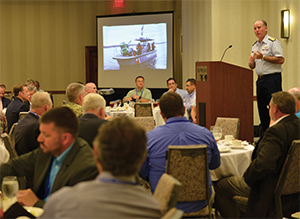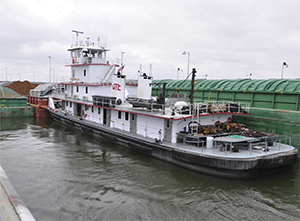Now that Subchapter M — the U.S. regime for the inspection of towing vessels — is law, the next step will be for companies to begin the compliance process.
The Coast Guard has begun meeting with industry members to talk about how the Subchapter M process will evolve over the coming year. And the approval process for companies that will work with operators to help them comply with Subchapter M has also begun.
Owners and operators have six years from last July to meet the requirements of Subchapter M, but their vessels will have to come into compliance within two years. During that time, companies will have to choose one of two options: a traditional Coast Guard routine inspection every year, or a towing safety management system (TSMS) approved and verified by a third-party organization (TPO).
The Coast Guard has just started approving third-party organizations. As of late December, the service had received less than 10 applications, according to Cmdr. Jackie Twomey of the Coast Guard’s Towing Vessel National Center of Expertise (TVNCOE). As of mid-January, four entities had received TPO approval: Marine Compliance LLC, WaveCrest Offshore Solutions Inc., Sabine Surveyors Ltd. and the Towing Vessel Inspection Bureau. Twomey expected more approvals by the end of January.
“The process will become shorter,” she said. “With it being a new process, the first ones are taking us some time.”
The TVNCOE had a meeting to discuss safety management systems and the requirements for becoming a TPO with prospective companies on Dec. 14. The next day, there was a meeting with classification societies.
 |
|
Inspectors from Marine Safety Unit (MSU) Portland conduct a field dry-dock examination in August 2016. The session held by the Coast Guard at the Oregon unit was the second in a series of national forums designed to educate towing vessel operators about Subchapter M. |
|
Courtesy U.S. Coast Guard |
“It’s coming together, but there is still a lot of uncertainty because the Coast Guard has a number of questions to answer about how this is going to work,” said Chris Parsonage, executive director of the Towing Vessel Inspection Bureau. For example, “how much oversight will (the Coast Guard) have over TPOs and how much oversight will TPOs have over our clients?”
It will be a collaborative process with the industry, Twomey said.
“The Coast Guard is committed to understanding where the questions are and how we can focus our efforts on providing feedback to the industry and how it can help us provide guidance,” she said. “Everybody who is associated with this knew there would be a lot to do this year.”
A major step forward was taken on Nov. 21 when the Coast Guard accepted the American Waterways Operators’ Responsible Carrier Program (RCP) as a safety management system that meets the requirements of Subchapter M.
“This is a significant milestone in the implementation of Subchapter M,” said Rear Adm. Paul Thomas, Coast Guard assistant commandant for prevention policy. “This is an important first step in instilling a culture of safety across the towing industry.”
The approval gives AWO members a leg up in the Subchapter M process, according to Jennifer Carpenter, the group’s executive vice president and chief operating officer.
“What this means is that AWO members will be able to use the SMS (safety management system) that they have been living with as a company,” she said.
 |
|
Coast Guard Rear Adm. Dave Callahan, 8th District commander, speaks to members of the Gulf Intracoastal Canal Association last August in New Orleans. One of the points of discussion was the Coast Guard’s outreach on Subchapter M and working with operators to implement it. |
|
Courtesy U.S. Coast Guard |
Companies will still have to incorporate Subchapter M requirements into the RCP. “What this really means is that (companies) are 95 percent of the way there,” Carpenter said. “They still have to make sure they are in compliance with the specific requirements of Sub M.”
The AWO is giving members a Subchapter M compliance guide, but they will still have to go to a Coast Guard-approved third-party organization to get the TSMS issued.
Classification societies already have been approved as third-party organizations. The American Bureau of Shipping has issued a guide for building and classing Subchapter M towing vessels, and ClassNK has a team ready to work with operators.
Kevin Gilheany, owner of Maritime Compliance International, said there are three things operators should do right away: all management should read the entire final rule, including the preamble; all captains should read the regulations; and everybody should start getting their vessels surveyed by people who understand the regulations.
“Towing vessel operators need to know how the requirements of Subchapter M may impact their business and what they should do to prepare for and manage them,” states a passage from the company’s website. “Subchapter M is complex with numerous subsections whose applicability will vary from vessel to vessel.”
This will help operators prepare a budget to determine what the cost of compliance will be. Companies should “get all their boats surveyed — get a good quality survey — to report on what needs to be done to get up to speed,” Gilheany said.

